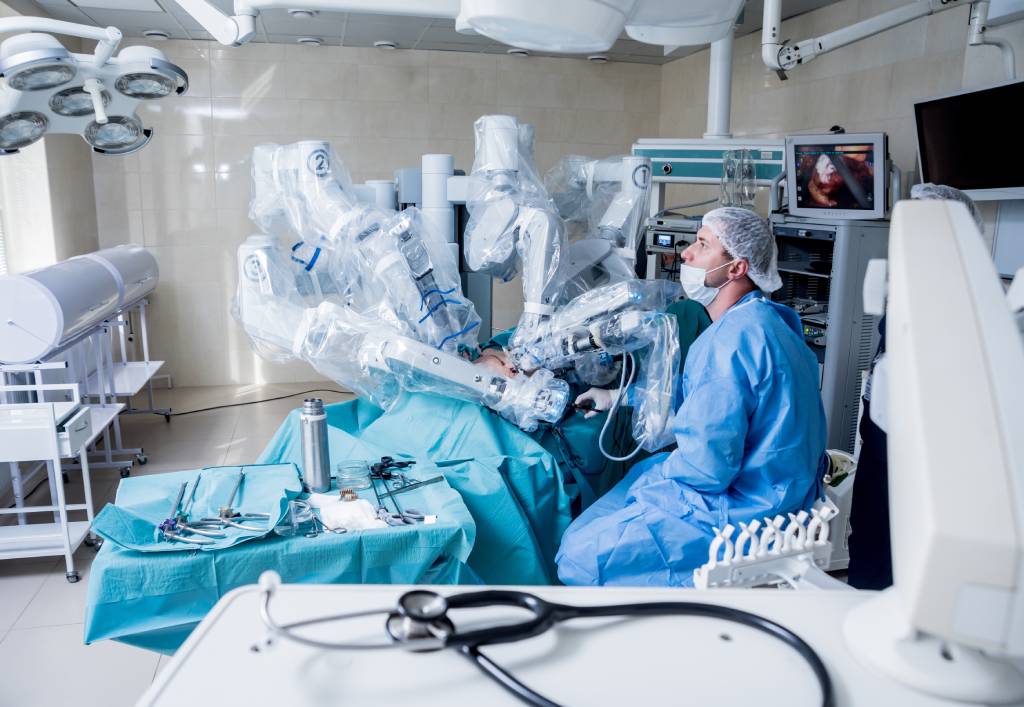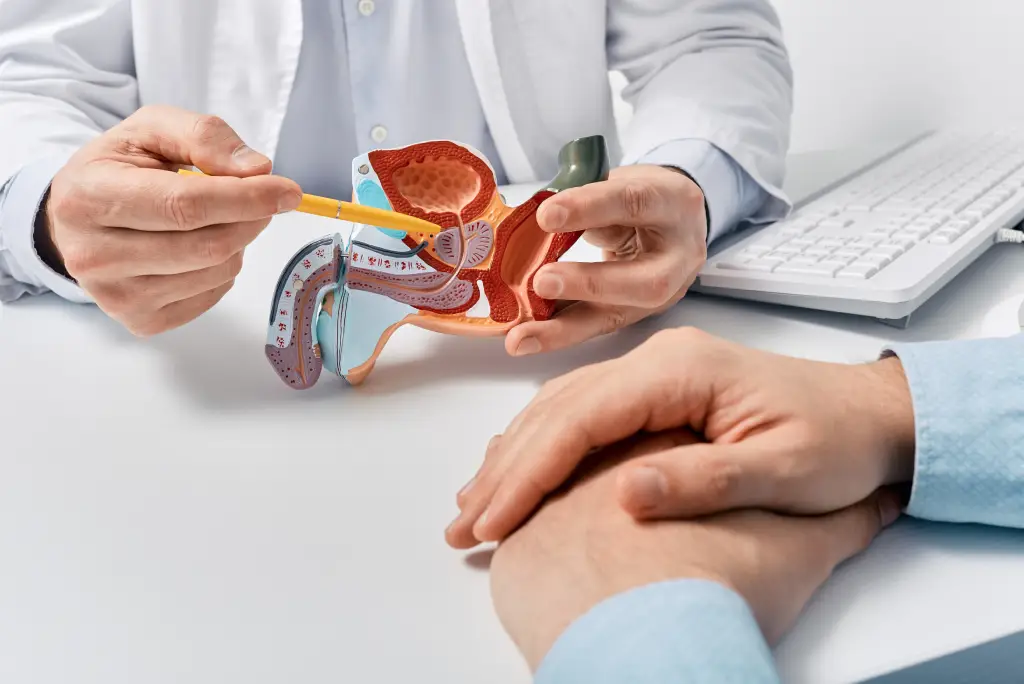Prostate cancer is the second-most common cancer diagnosed in men.
Despite its prevalence, prostate cancer has a notably high survival rate. The American Cancer Society explains that, for both localized and even regional prostate cancer, the five-year relative survival rate with treatment is higher than 99%.
Many factors have influenced this high rate of survival for prostate cancer in its earlier stages. That includes screening efforts and a variety of proven and effective treatments, among others.
Learning more about the options available to treat prostate cancer is important for individuals at risk of this disease and those who have been diagnosed with it. Education can lead to a more informed decision about treatment in consultation with a physician.
Surgical treatments are a common option for prostate cancer. In some cases, they present the most effective option when the stage of the cancer, a patient’s overall health, and other important factors are taken into consideration.
However, side effects from prostate surgery are worth learning about as well. In situations where there are multiple reasonable treatment options (including less-invasive treatments that have a lower risk of side effects compared to the alternatives) may effectively address prostate cancer, for example, the types and frequency of side effects are important differentiators.
Now, let’s review some common surgical treatments for prostate cancer. We will take side effects into account as well.
Common Surgical Treatments for Prostate Cancer & Surgery Side Effects
Radical prostatectomy — meaning the complete removal of the prostate — is the main type of surgery used to treat prostate cancer.
As Johns Hopkins Medicine explains, radical prostatectomy is normally used to treat prostate cancer that has not spread to areas of the body distant from the prostate. By removing the prostate and some nearby tissue, such as the seminal
vesicles, physicians aim to eliminate cancerous cells from the body.
A radical prostatectomy may be performed by itself or in combination with other treatments, such as radiation therapy or hormone therapy.
While all radical prostatectomies have the goal of removing the prostate, there are several distinct types of this surgery. These methods are differentiated by the location, size, and number of incisions, the potential use of a robotic system, and other factors.
Other types of surgery used to address prostate cancer include transurethral resection of the prostate (TURP) and orchiectomy (commonly known as castration), as the American Cancer Society details.
However, TURP is used to alleviate prostate cancer symptoms in advanced cases as opposed to directly treating the cancer itself. Similarly, orchiectomy is used to alter hormone levels and temporarily stop the growth of prostate cancer. It is not a treatment that directly removes prostate cancer through surgery.
Keep reading to learn more about common types of radical prostatectomy and the side effects of these procedures.
Retropubic Radical Prostatectomy
In this form of radical prostatectomy, “retropubic” refers to the length and type of incision. The surgeon will make a single, long incision that starts near the navel and reaches down to the pubic bone to gain access to and remove the prostate.
This type of prostate cancer surgery allows the surgeon to remove nearby lymph nodes and have them tested for cancerous cells. This helps confirm that the cancer has not spread, and a radical prostatectomy is a useful treatment.
A retropubic radical prostatectomy requires either local anesthesia in the lower half of the body along with sedation or general anesthesia. Additionally, a catheter is inserted and commonly kept in place for a week or two following the procedure.
Perineal Radical Prostatectomy
A perineal radical prostatectomy is distinguished by the incision’s location, between the scrotum and anus. It is a less-common procedure for two important reasons, as Johns Hopkins Medicine explains:
- It is more difficult to protect (or spare) surrounding nerve tissue, which can lead to prostate surgery side effects like loss of erectile function.
- Nearby lymph nodes cannot be removed for testing before moving forward with the procedure.
However, this method often can be completed more quickly and can lead to a shorter recovery time. Anesthesia and catheterization following surgery are also required for this treatment.
Laparoscopic Radical Prostatectomy
In general, laparoscopic surgery utilizes several small incisions in the abdomen instead of a single, large incision. This makes laparoscopic prostatectomy less invasive than traditional versions of this procedure. A laparoscopic prostatectomy includes a camera (the laparoscope) inserted through one incision and specialized surgical instruments inserted through the others.
Robot-assisted prostatectomy, where a robotic system is controlled by a surgeon and helps to make precise movements with those instruments, is
a common form of laparoscopic prostatectomy. However, surgeons will directly manipulate the instruments in some situations.
The American Cancer Society points out that this type of prostatectomy compares favorably to more traditional surgeries in some important ways. These include reduced blood loss during surgery, less pain following the operation, and shorter recovery time, among other potential benefits. The results of traditional and robotic prostatectomies are about the same in terms of long-term outcomes.
Prostate Surgery Side Effects
Potential side effects of prostate surgery (i.e., radical prostatectomy) include:
1. Loss of Penile Length
Radical prostatectomy can cause a loss of penile length as a result of the procedure. VeryWellHealth mentions a decrease in blood flow and structural changes following surgery as potential causes.
Research published in the Journal of Urology found that, among 105 men receiving an open (non-laparoscopic) radical prostatectomy, penile length reduced by an average of 1 cm at three months after surgery. However, the research also found that length recovered by 48 months after surgery.
However, Dr. John Mulhall, director of the Male Sexual and Reproductive Medicine Program at Memorial Sloan Kettering Cancer Center, told Reuters that some men experience a permanent loss of penile length following surgery.
2. Erectile Dysfunction
A radical prostatectomy can damage nerves surrounding the prostate, causing partial or total erectile dysfunction.
A research review published in the medical journal Current Opinion in Supportive and Palliative Care explains: “While there is a large discrepancy in prevalence rates of ED after RP, several recent studies have cited rates as high as 85%.”
Partial or full loss of erectile function can have a major impact on quality of life and mental health, making it especially important to consider as a side effect. Nerve-sparing approaches for men with otherwise healthy erectile function can reduce the incidence of this side effect. However, the location of the cancer and other complications can still lead to erectile dysfunction.
3. Urinary Incontinence
Radical prostatectomy can damage the system that helps the body control urine, leading to issues with incontinence. While rehabilitative processes and absorbent pads can help to address and control the effects of this issue, it can significantly impact quality of life and mental health.
A review and analysis published in the medical journal European Urology found that, even with the support of robotic assistance, the mean rate of urinary incontinence 12 months after the procedure was 16%. This is an influential robotic prostate surgery side effect to keep in mind.
4. Surgical Complications
As with many invasive surgical procedures, short-term complications can arise during or shortly after treatments. Excessive bleeding, infections, and negative reactions to anesthesia are a few examples. These risks can become less or more severe depending on overall health, among other factors.
Minimally Invasive Options for Treating Prostate Cancer
Some patients can consider less-invasive options for treating prostate cancer. Through more precise targeting of treatment, advanced MRI imaging before and during the procedure, heat monitoring, and other factors, these minimally invasive outpatient procedures compare favorably to radical prostatectomy in terms of side effect incidence.
For example, Laser Focal Therapy (LFT) (also known as FLA focal laser ablation) is a potential option for low- to intermediate-risk disease localized to the prostate with well-defined lesions. Occasionally, this may also be a reasonable option for some cases of high-risk disease. Similarly, Transurethral Ultrasound Ablation (TULSA-PRO) is a potential option for patients with low- to intermediate-risk disease that is limited to the prostate, but more diffuse.
This reduced risk is apparent in terms of erectile dysfunction following these procedures. LFT has an erectile dysfunction risk of 10%, according to clinical trial results for the procedure. TULSA-PRO demonstrates a risk of 25%, according to its clinical trial data.
The urinary incontinence incidence for both procedures is also significantly lower than that of a radical prostatectomy. The same clinical trial data for both procedures show us that:
- LFT has a urinary incontinence risk of less than 3%.
- TULSA-PRO has a urinary incontinence risk of 7%.
While not every patient is a candidate for these minimally invasive procedures, they are options worth considering for patients who qualify.
Prostate Laser Center (a Halo Diagnostics Company) is proud to offer these lower-risk, customizable, and effective prostate cancer treatments to patients.
Looking for less-invasive treatment options for prostate cancer? Request your consultation today.
NOTE: The information provided on this website is general medical information and does not establish a physician-patient relationship. Please discuss your particular situation with a qualified medical professional.



